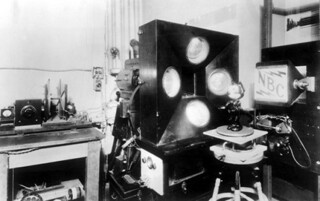Broadcasting Felix
Tom Overton
In 1928, a foot-high papier-mâché Felix the Cat was the first image to be broadcast on TV, spinning round on a turntable in the NBC studios in New York to test the new technology. Felix has always been a self-aware screen star. In the silent film Felix in Hollywood (1923), he shapeshifts into a bag (tail as handle) for his owner, a hard-up artist, to carry to the movie studios. Once there, he detaches his tail and uses it as a cane to mimic Charlie Chaplin, before realising the man himself isstanding behind him. In the end he gets a studio contract.
Felix Gets Broadcasted (1923) starts with him stealing fish from an angler. The puns on casting continue when Felixjumps of the roof of a shack marked ‘P.D.O. BROADCASTING STATION’ and scurries up a telegraph pole onto some wires. The angler cranks a lever in the shack and the wires catapult Felix off intoancient Egypt, where he makes the Sphynx sneeze and a crocodile chases him. The technology of the near future has sent him into an archaeological past. But it’s the past as imagined through themass-media clichés which mechanical reproduction – and soon broadcasting – made possible.
Felix has at least seven different avatars in Mark Leckey’s exhibition at the Grundy Gallery in Blackpool. They include Leckey’s version of Felix Gets Broadcasted (2007), a reconstruction not of the 1923 cartoon but of the 1928 TV broadcast, and an enormous inflatable Felix. Mercury Tail (2015) is an LCD display of the most versatile part of Felix’s anatomy, the form mimicked by the curving stand it’s mounted on.
The new piece in the Blackpool show, an Arts Council Commission called FEELINTHECAT, is a walk-in cardboard dome shaped like Felix’s head. It’s furnished with two eye-like TV screens which project an image of Leckey in a Felix costume, groaning as if hungover and stretching on an office carpet. At the opening, I overheard two schoolgirls peering quizzically at FEELINTHECAT. ‘You can go in!’ one said. ‘Oh my god!’ said the other.
The implication seems to be that, with all the ways we broadcast ourselves and are broadcast in the age of wireless internet, we’re all avatars of Felix. Douglas Coupland’s Kitten Clone (2014), written in residence at the telecoms firm Alcatel-Lucent, makes much of the idea that, as well as selfies, a lot of bandwidth is used for transmitting pictures of cats. On the way out of Leckey’s show, I saw the categories merge: people were posing for cameraphones in front of Flix (2008), a 16mm projection of Felix’s tail, curling and flicking expressively as though it were attached to them.
Read more in the London Review of Books
J. Hoberman: Disney, Benjamin, Adorno · 24 July 2003
Elif Batuman: Graphic Novels · 10 April 2008
Hal Foster: A potted history of technology via the player piano · 24 July 2003
